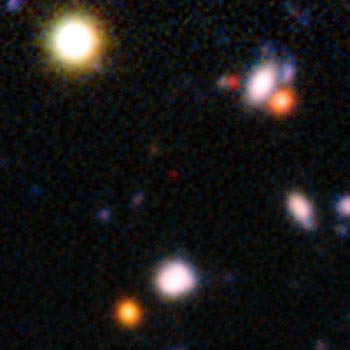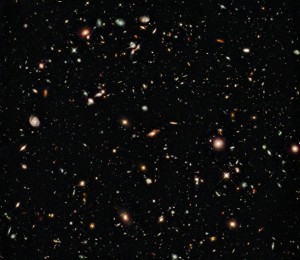 Take a look at the image displayed here [click to redshiftenate]. Every object you see there is a galaxy, a collection of billions of stars. See that one smack dab in the middle, the little red dot? The light we see from that galaxy traveled for 12.9 billion years before reaching the ESO’s Very Large Telescope in Chile. And when astronomers analyzed the light from it, and from a handful of other, similarly distant galaxies, they were able to pin down the timing of a pivotal event in the early Universe: when the cosmic fog cleared, and the Universe became transparent.
Take a look at the image displayed here [click to redshiftenate]. Every object you see there is a galaxy, a collection of billions of stars. See that one smack dab in the middle, the little red dot? The light we see from that galaxy traveled for 12.9 billion years before reaching the ESO’s Very Large Telescope in Chile. And when astronomers analyzed the light from it, and from a handful of other, similarly distant galaxies, they were able to pin down the timing of a pivotal event in the early Universe: when the cosmic fog cleared, and the Universe became transparent.
This event is called reionization, when radiation pouring out of very young galaxies flooded the Universe and stripped electrons off of their parent hydrogen atoms. An atom like this is said to be ionized. Before this time, the hydrogen gas was neutral: every proton had an electron around it. After this: zap. Ionized. This moment for the Universe was important because it changed how light flowed through space, which affects how we see it. The critical finding here is that reionization happened about 13 billion years ago, and took less time than previously thought, about 200 million years. Not only that, the culprit behind reionization may have been found: massive stars.
OK, those are the bullet points. Now let me explain in a little more detail.
Young, hot, dense, and chaotic
Imagine the Universe as it was 13.7 billion years ago. A thick, dense soup of matter permeates space, formed in the first three minutes after the Big Bang. The Universe was expanding, too, and cooling: as it got bigger, it got less dense, so the temperature dropped. During this time, electrons and protons were whizzing around on their own. Any time an electron would try to bond with a proton to form a neutral hydrogen atom, a high-energy photon (a particle of light) would come along and knock it loose again.
During this period, the Universe was opaque. Electrons are really good at absorbing photons, so light wouldn’t get far before being sucked up by an electron. But over time, things changed. All those photons lost energy as things cooled. Eventually, they didn’t have enough energy to prevent electrons combining with protons, so once an electron got together with a proton they stuck together. Neutral hydrogen became stable. This happened all over the Universe pretty much at the same time, and is called recombination. It occurred about 376,000 years after the Big Bang.
 When this happened, the Universe became transparent to visible light because neutral hydrogen is really bad at absorbing the kind of light we see. However, it’s really good at absorbing ultraviolet light, and that’s the key to our story. Up until this point, there were no stars, no galaxies. But over time, hundreds of millions of years, the gas and dark matter in the Universe clumped up, attracted by their mutual gravity, and started forming galaxies and stars. Some of these stars were massive, hot, and bright, and flooded the sky with ultraviolet light.
When this happened, the Universe became transparent to visible light because neutral hydrogen is really bad at absorbing the kind of light we see. However, it’s really good at absorbing ultraviolet light, and that’s the key to our story. Up until this point, there were no stars, no galaxies. But over time, hundreds of millions of years, the gas and dark matter in the Universe clumped up, attracted by their mutual gravity, and started forming galaxies and stars. Some of these stars were massive, hot, and bright, and flooded the sky with ultraviolet light.
This UV was then promptly absorbed by the neutral hydrogen out in space. If the UV photons had enough energy, kablam! They’d blow an electron right off its hydrogen atom, ionizing it. For hundreds of millions of years, the universe was neutral, but then those pesky stars fired up, and started ionizing it again. That’s why we call this reionization.
Not only that, but all this time the Universe was still expanding. As it did, it got less dense, the matter spreading out more thinly over space. Once the stars started ionizing the hydrogen, the average distance between the electrons and protons was getting big enough that it was tough for them to recombine (and if they did, along came another UV photon, pinging off the electron again). Between the flood of UV light and the cosmic expansion, the Universe stayed ionized. It was such an efficient process that today, 13 billion years later, the Universe is still mostly ionized. Neutral hydrogen is pretty rare compared to its ionized brethren.
A long time ago, in a bunch of galaxies far, far away…
And that’s where these new results (PDF) come in. The astronomers studied a handful of galaxies at different distances. They are so far away that the light we see from them was emitted around the time of reionization. By looking at the amount of ultraviolet we see from these galaxies, we can determine how much neutral hydrogen it passed through (since that gas absorbs the light, making the galaxy appear fainter) versus ionized gas. These galaxies were all very far away, but not exactly the same distance. Remember, it takes time for light to reach us, so we may be seeing one galaxy as it was 13 billion years ago, and another as it was 12.9 billion years. That makes a big difference! Because these galaxies were at different distances, it allowed the astronomers to see what reionization was like at different times.
Sure enough, the most distant galaxies had more of their UV light absorbed than the ones that were closer. What the astronomers found was that 780 million years after the Big Bang the Universe was mostly neutral, but only 200 million years later was mostly ionized. In other words, the flood of UV radiation managed to ionize essentially the entire Universe in only 200 million years, faster than what had previously been supposed!
Ah, now it’s all clear to me
Think about that for a moment. We are looking at objects that are so far away it takes huge telescopes just to see them at all, despite the fact that they are blasting out UV radiation at a rate that makes them billions of times brighter than the Sun. We are peering across the entire Universe to see what it was like when it was young, very young, and we’re able to actually see what it was doing, and understand it.
That’s so cool.
Not only that, but another team of astronomers independently added to this finding by solving another riddle about it. I wrote above that it was stars that reionized the Universe, but in fact that’s not the entire story. Giant black holes gobbling down matter are sloppy eaters, and as material falls in it blasts out high-energy radiation, including UV, as well. How much of that reionizing UV light was from stars, and how much from those big black holes?
[Click to galactinate.]
The other study (PDF) looked at nearby galaxies that are emitting lots of UV light, more than usual for normal galaxies, and were probably more common in the early Universe. The image above is one such galaxy, NGC 5253, as seen by the Magellan Baade 6.5 meter telescope. They found that these galaxies are undergoing bursts of star formation, and that means lots of massive, hot stars that can flood space with UV. Calculating how many stars are formed, how much UV is emitted, and extrapolating that back to the early Universe, they find that stars were the main culprit in reionizing the Universe 13 billion years ago.
That’s amazing. Stars were so plentiful and so energetic even so long ago that they were capable of ionizing the entire Universe!
The proper study of the Universe is the Universe
One thing that may be confusing (OK, a lot of this is, but one thing that stands out) is that if the Universe is currently ionized, and free electrons are so good at absorbing light, why isn’t the Universe opaque today? It’s because the Universe is so thinly spread out! Sure, electrons absorb light, but there are simply so few of them in space that your random photon from a distant galaxy has a very good chance of traveling billions of light years without getting close enough to one to impact it and get swallowed up. That’s why the Universe is transparent, and allows us to see nearly all the way across it.
So you have to consider not just that neutral hydrogen is good at absorbing UV and bad at visible light (and the opposite when it’s ionized) but also how dense it is. Way back in the olden days it was thick enough to absorb light, but now, even though it’s ionized, it’s too thin to absorb light efficiently. That happened around the same time as reionization, so once the hydrogen got zapped, it stayed zapped.
I know it’s a little confusing, but the universe is a fairly complicated place. That’s why we’re still trying to figure it out! We think the rules it obeys, the laws of nature, are actually relatively simple and elegant. But there are a lot of them, and they interact in complex ways. If they didn’t, we wouldn’t be here to study them! So really, if you think about it, we are the result of the Universe’s laws made incarnate, evolved to the point where we can study ourselves.
Image credits: ESO/ L. Pentericci; NASA/ESA/Hubble; Jordan Zastrow
Related posts:
- The Universe is 13.73 +/- .12 billion years old!
- Record-breaking galaxy found at the edge of the Universe
- Galaxy cluster at the edge of the Universe
- Hubble digs deep to see baby galaxies